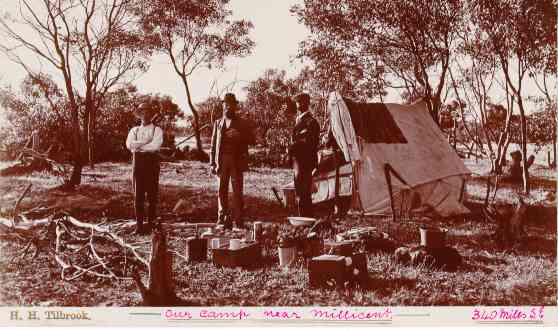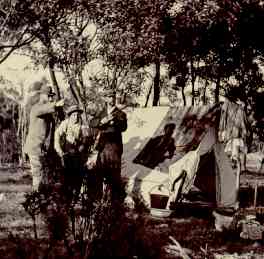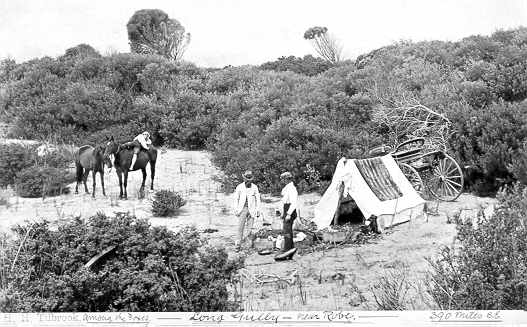
1900 – Mount Gambier to Robe.
On 15 March 1900 Henry Tilbrook returned to Mount Gambier for another excursion with his friend Fred Lester. The party consisted of Henry, Fred Lester, a sixteen year old boy, Leslie Howlett, and a black retriever dog named Quimbo. ‘The trap was a four-wheeler, in good order. It was well loaded with paraphernalia all over it - underneath the axles as well. … Unfortunately my journal for this trip was taken away by some mischievous hands and I am dependent upon memory and my photographic notes for the production of this set of writings.’
‘We drove through the town of Millicent without stopping. This being Saturday afternoon people were gathering there from twenty miles around. Young men on horseback, dressed in their Sunday best, were riding in from every point of the compass, almost, to see their Dinahs. Truly, Saturday was the business people's harvest time! And what about the pubs? We did not stay to see. None of us were public-house habitues.’
They camped near the drainage channel on the north side of the town and the next morning Henry photographed the party by their tent. The photograph (below) was taken on 18 March 1900.
Below: Henry Tilbrook used his enlarger not only to make large pictures to hang on the wall but also reduced them to postcard size like this photograph, "Our camp near Millicent." As often mentioned in his reminiscences, he is winding up a long thread which triggers the shutter on the camera so he can be included in the picture. Left to right - Leslie Howlett, Henry Tilbrook, Fred Lester (by tent).

At one stage, while purchasing provisions at a store, ‘a young lad called out to us that Kimberly, in South Africa, had been relieved by Lord Roberts. This, of course,’Henry wrote, ‘was welcome news to us.’
 |
Left: In this photograph the party is pretending to be taking a shot at the legendary Tantanoola Tiger. Henry writes: ‘Accordingly in the stereoscopic view of our camp while winding up the thread of the camera with one hand I am pointing out the tiger to Lester who is eagerly looking for a soft spot behind its shoulder wherein to plant the fatal bullet while Leslie is interestingly looking on.’ Enlarged section of one frame of a stereo pair. |
19 March - At Lake George -- ‘I took a photo of our camp. There was no elevation to take a panoramic view from. But I had made myself an extending camera stand of four joints with a sliding-extension in the bottom section for emergencies of this kind. Thus by throwing out the sliding part I raised the camera high enough above the top of the brushwood to obtain a fair prospective view of the lake and its surroundings with our camp included in the foreground.’
20 and 21 March 1900 -- ‘In the morning I photographed our camp. I used my invention, the long-reaching reel of thread which when pulled or wound up dislodged a one-and-a-quarter ounce Martini-Henri rifle bullet. This set the shutter working without any vibration, the bullet falling to the ground as soon as it had started the mechanism of the shutter. By using this I could get into the photo myself. Leslie lay on his back on the broad back of one of our horses whilst Lester and I were apparently busy at the campfire. In reality I was quietly winding up the reel of thread in my left hand, the thread being placed out of sight on one side under the little wire pegs. The photo being taken I went away exploring.’
Below: "Among the Foxes. Long Gully near Robe." From Henry's postcard copy of the photograph referred to in the paragraph above.

22 March 1900 -- The party headed for Nora Creina Bay. Henry wrote: ‘The name will be found on some maps, but not on all. However, I have since made the place known by taking the picture of The Archway. So I have no doubt the name will be inserted in all Government maps in the future. The picture has been reproduced in many newspapers as well as being placed in the first-class carriages of the South Australian Railways. Sir Langdon Bonython wrote me asking for a copy for an American publication whose editor wished to publish it. So I sent him one and he forwarded it to America where it was published. The American people had the courtesy to send me a number with the picture in it. It was exceedingly well reproduced. The book, for such it may really be termed with its one hundred and sixty pages, quarto size, is called The Inland Printer, published in Chicago, U.S.A. At the foot of the picture are these words - "Natural Archway, Nora Creina Bay, South-East coast of South Australia. Photo by H.H. Tilbrook." That was the title I gave to the picture myself.’
Henry described photographing the Great Archway at Nora Creina Bay. ‘In taking this photo I had the greatest difficulty in getting it into the whole-plate. The back space was restricted. I had my camera on the extreme edge of a precipitous rock. The rock went down perpindicularly to a great depth behind me, and I was standing on the very last inch of space on the edge. There I had to focus and manipulate the unweildy whole-plate camera and slides. In this I was successful without mishap. A step backwards would have precipitated me on to the rocks below.’
At Nora Creina Bay they found a small hut. ‘It belonged to fishermen who came to the spot occasionally. Just one sandhill separated it from the bay. It was built of palings, with thatched roof and big stone chimney. The door was gone. As soon as we took possession I proceeded to make a big broom from branches of the surrounding trees, and swept a dray load of rubbish off its sandy, earthern floor. That night it rained. The roof leaked. I put more thatch on it in the morning.’
Below: "Our Camp in a Fishermen's Hut, Nora Creina Bay, S.E. Coast."

‘At this fisherman’s hut an out-of-the-common incident took place. The dog Quimbo took the photograph without asking my leave. It was this way. I was focussing the hut and had laid the reel of thread on the ground under the little wire pegs. Asking the others to take up their positions whilst I went up to the camera to make final adjustments I heard the shutter click prematurely. Looking around I saw that the dog had run across the thread and pulled it with his legs - or rather hsd pushed it - and had thus taken the photograph! I had set the shutter for one-quarter of a second. Thus Quimbo who was in the view) being on the move was blurred on the plate, and I was left out of the scene. I could have made the exposure the fifteenth part of a second, or even the ninetieth part, had I known. His image would then have been clear and sharp. I presume that is the first time in history that a dog has taken a photograph with himself in the group.’
25 March 1900 -- ‘At dusk we got to some high land in a silted up portion of Lake Frome and camped hastily alongside a scrub of very high teatree… In our hurry we did not allow for an almost certain change of wind in the night. And change it did, to the west, leaving us exposed to the full force of the gale. Fortunately we had put our conveyance against the stormy side of the tent which sheltered us somewhat. It rained the whole night long. We, the tent, and the luggage were all dripping wet. The tent was on the point of being blown down in the night. I got up hastily in my night apparel, hitched a rope to the top of the tent pole, and fastened the other end to a handy tree stump. This saved our domicile from destruction.
‘My photo taken next morning in the rain and gale shows the tent bellying out with the guy rope stiff as an iron bar. That photograph was taken under great difficulties. Fallen timber lay all over the ground. I had trouble in getting the camera to stand up whilst the focussing was a matter of time and patience in the face of the storm. At last everything was ready. Then I got young Leslie to come out of the tent and squeeze the pneumatic bulb of the shutter while I stood in position wrapped in a macintosh. The exposure was timed for half a second. Everything was on the move. I have an enlargement of that picture and I value it highly. In the distance the waters of Lake Frome are shown clearly, the clearness being brought out by my use of chromatic plates and with a yellow or a yellow-and-green glass screen between the lens and the dry plate. The screen lengthened the exposure by three times. The day was exceedingly dull, too, and the storm was raging the whole time. In the picture everything appears gloomy all around. A wild duck is hanging from the tent post; the tent is nearly bursting outwards, and is showing one big slit; dark fallen timber is in the foreground; and it shows one of the most uncomfortable camps one could wish for. Yet with favourable weather it would have been one of the best. I value the picture also as showing some of the discomforts we had to endure.’ The photograph Henry has just described is shown below. Copied from an enlargement in one of his albums.
Below: Henry Tilbrook's photograph - ‘A Wet Encampment on Lake Frome, S.E.’

The party returned to Mount Gambier on 27 March 1900 and the next day left on a trip to Cape Northumberland and Port MacDonnell. ‘At one spot on the journey a very fine view of Mount Schank could have ben taken with my telephotographic lens but for the rain and mist. I marked the spot and mentioned to Lester that I would take it coming back. But it was dark when we returned, and I lost the chance of getting a view that I should have valued highly.’
They reached Cape Northumberland and ‘pitched tent under the shade of some ordinary, high thick-brushed teatree, which was then in flower. Not far away, eastward, was an inhabited house whose occupants kindly gave us leave to use water from their rainwater tank... In the morning we started off, upon pleasure bent - my two mates fishing, I taking photographs and exploring.’
Henry photographed the lighthouse and other scenes at Cape Northumberland. It was not easy. ‘The wild winds blew, and the flying sand cut into my flesh, stinging like small shot. It was impossible to keep it out of one’s eyes. As I have mentioned, I always carried an umbrella to protect the camera from the wind, but even then it was with the utmost trouble that I was able to take the views. The work, too, was exhausting, going down and climbing up the steep, high, crumbling cliffs, using my legs and feet only, my hands being full of paraphernalia.. Several times I fell, rolling many feet down, but never letting go of what I held in my hands. That is a habit of mine -- an instinct, I think.’
‘At one spot some miles north of Cape Northumberland, and one mile back from the sea, we found the site of a native camp of long ago. It was said to be an ancient battlefield. Human bones were peeping out of the sand in abundance. I piled some of these into a heap and took a stereoscopic photo of them... My mates were never with me while I was taking photos. They put in their whole time fishing.
‘From our camp Leslie was sent to the house before-mentioned for our domestic drinking water. An attractive girl was there. She asked him if I would take her photograph at the house. Now, I was tired of taking other people's portraits at my own expense. I thought that if she could be induced to grace the view of our camp with her presence in the group, it would lend enchntment to the scene. But she could not overcome her bashfulness -- and thus she lost the opportunity of a lifetime to make one of an eminent group! Country girls are often prudish like that. She was only fifteen... At Shelly Bay I saw one party of bathers arrive from parts unknown. They went in for mixed bathing, and seemed to enjoy themselves. I took one fine view of this bay. It would make a fine scene for an artist's brush... On the way home it was too late when passing Dingley Dell to take a photo of Adam Lindsay Gordon’s birthplace. In reality the house was too commonplace and unromatic to be worth a plate, yet I wished a photo of it. We reached Mount Gambier late, cold and wet. Notwithstanding this, I had to sit up till midnight changing plates for Monday.’
2 April 1900 -- ‘This morning saw me on the train bound for my beloved in Adelaide. A heavy fog lay on the land. The tops of the trees showed above it. The narrow-gauge train dragged its slow length along as though it were a life journey. We rumbled -- and rumbled -- and rumbled. The air was keen, the carriage draughty. No comfort at all. All sorts of people. Young misses with the world before them. Italian potato-diggers with their whole-hearted good-looking wives...’
After a long train journey Henry reached Adelaide railway station. ‘There on the platform, all smiles, dimples and expectation stood my handsome sweetheart. No tears in her eyes now... All my photos turned out successful without the loss of a single plate. My beloved helped me in the fixing and washing of all the prints. It was through her that I took such an interest in photography. I printed several copies of every one and sent many of each to my Mount Gambier friends and others.’
END.